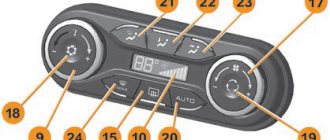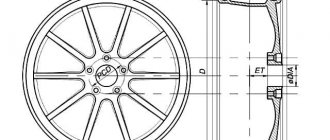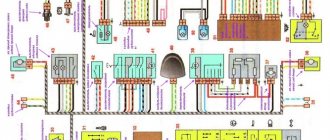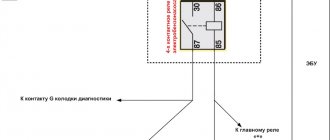How it works
A modern car climate control system includes the following main components and mechanisms:
- air conditioner – helps cope with excessively high temperature and humidity;
- car heater - heat is taken from the heated engine coolant;
- fan – provides air mixing inside the cabin;
- system of air ducts and intakes - makes it possible to distribute air flows and direct them to the required point in the cabin;
- air intake curtains are driven by electric servo drives;
- electric stove valves - cut off the heat exchanger when there is no need for heat;
- thermal sensors – measure the air temperature at different points in the cabin;
- humidity sensor - not used in older models;
- software controller - analyzes sensor data and gives commands to turn on actuators.
Air conditioning system operation diagram
The operating principle of climate control in a car in winter is as follows:
- the driver sets the required temperature in the cabin, for example, 23 degrees;
- the installation is switched to “auto” mode;
- the controller analyzes data from temperature sensors and compares it with the task;
- if the temperature in the cabin is higher than the set one, then the air conditioner turns on (in winter this is practically impossible);
- if the temperature is lower than the set one, then the electric valves of the heater open, antifreeze is supplied to the radiator from the engine cooling system;
- Based on the difference between the actual temperature and the set one, the controller gives a command to turn on the required fan speed, taking into account the degree of heating of the coolant in the stove;
- if necessary, the “Recirculation” mode is automatically activated;
- When the set temperature is reached, the controller reduces the blowing speed and switches the system to maintenance mode.
Four-zone climate control
How to independently check the efficiency of the Lada Granta air conditioner?
Self-checking the effectiveness of the climate system is quite simple. All you need to do is turn on the air conditioning in your car and focus on the following aspects:
- Normally, switching on is necessarily accompanied by a click, which indicates that the pressure disk has engaged with the drive pulley and that the compressor rotor has begun to rotate.
- At the same time as the air conditioner, the electric fan of the cooling system must also turn on.
- At the same time, the temperature of the air flows coming from the air ducts begins to decrease. If nothing like this happens, it is necessary to check the condition of the accessory drive belt.
The absence of a click when the climate system is turned on may indicate several violations in its operation, namely:
- About a freon leak causing the compressor to be blocked from starting.
- About the breakdown of the pressure sensor.
- About the presence of a malfunction in electrical circuits.
- About a possible break in the electrical circuit of the clutch coil winding.
- About blocking the start of the compressor for other reasons (for example, due to a dead battery).
The presence of any extraneous noise most often signals the beginning of destructive processes in the air conditioner clutch bearing. At the same time, it can get very hot, and then you will feel a specific smell.
If the clutch rotates freely, accompanied by extraneous noise (the engine often stalls), we are most likely talking about a jammed compressor. Its internal filling cannot be repaired, and therefore will have to be replaced.
Sometimes car enthusiasts note rotation of the compressor shaft and the simultaneous absence of even the slightest cooling of the air. In such a situation, only a specialist can determine the possible cause of the malfunction.
In addition, the cause of malfunction of the air conditioning system can be contamination of the condenser, and therefore you should not refuse its regular maintenance. But a weak air supply most often indicates problems with the cabin air filter.
Novaya Lada: F5 burns out when the heater is turned on to mode 4 [Archive]
Do not forget that all work on repair, maintenance and dismantling of air conditioners is recommended to be entrusted to professionals and carried out only in service centers. Car owners are advised to only clean air conditioning systems themselves. Such precautions are due to the fact that even a slight contact of freon on the skin will cause serious frostbite.
Features of operation in winter
The climate control algorithm described above is quite general. Each manufacturer develops a climate system for a specific model or series. The controller software may also differ slightly. The latest versions of electronic climate control allow the car owner to independently program some of the installation functions. The operation of climate control in a car in winter sometimes requires intervention and switching to manual control:
- The car was in an open parking lot and its windows were covered with ice. To start moving, you need to quickly clear the viewing areas from ice. Not all climate control firmwares provide for automatic pre-heating of the windows. There may be a situation where the program provides such a function, but the specified heating time was not enough. In this case, you have to exit the automatic mode and manually turn on the glass defrost. You will also have to choose the fan speed. Once the icing is cleared, you can return to automatic settings.
Humidity reduction function
Almost everyone knows that an air conditioner, while working to cool, dries the air. Not many people have heard how climate control in a car copes with this task in winter. To ensure this function, the installation is equipped with a special humidity meter. Data from this sensor is sent to the controller. At low negative temperatures, air dehumidification is usually not required; the stove can handle moisture vapor. The situation changes at temperatures close to zero, in conditions of wet snow, and during a thaw. The car windows begin to fog up intensely. In this situation, your climate control system will operate as follows:
- the humidity sensor will inform the controller about the need to remove excess moisture;
- the controller will give a command to turn on the air conditioner and stove simultaneously;
- moist air passing through the air conditioner evaporator will leave moisture particles in the form of condensation or frost on the heat exchanger honeycombs;
- After the evaporator, the air enters the stove radiator, where it is also further dried.
Thus, the use of climate control prevents the windows from fogging up and provides comfortable driving conditions in winter.
Cabin filter
Filter
Before using climate control in your car in winter, carefully read the car's operating instructions. In it you will probably find recommendations for replacing the cabin filter. This air purification element plays a very important role for the operation of the air conditioning system. If the filter is clogged with dust, then heating and drying will be ineffective - the windows will fog up, and the interior will heat up more slowly. Manufacturers offer three options for filter elements:
- paper - the easiest and cheapest cleaning method;
- coal - act much more efficiently;
- antibacterial - prevent the proliferation of pathogenic organisms in the air ducts of the car's air conditioning system.
It is recommended to replace the cabin filter twice a year. In some cases, the procedure will have to be performed more often - for example, when driving on dirt roads.
1200 rub. for the photo report
We pay for photo reports on car repairs. Earnings from 10,000 rubles/month.
Write:
The climate control system in the car provides comfort and convenience for the driver and passengers. Its main difference from an air conditioner is that it constantly maintains the specified climatic conditions. The system can be single- or multi-zone. Due to its complexity during operation, car owners may have a number of questions, in particular: “How to use the climate control? What to do if the climate control does not turn on ? How to clean climate control ? We will try to talk about this and much more in detail.
What is climate control in a car?
Automotive climate control (hereinafter referred to as CC) is a system consisting of an air conditioner, a heater, temperature and humidity sensors, a filtration system and an electronic control unit. The purpose of the system is to maintain the microclimate inside the car, regardless of the weather outside.
The operating principle of climate control is simple. It is based on the operation of an electronic feedback processor, which receives information from numerous sensors that record the temperature in different parts of the car interior. The user sets the desired temperature parameters in the control unit. And the processor supports them all the time, based on information from the sensors, and, if necessary, adjusting the operation of the cooling or heating systems.
Interestingly, the climate control includes not only an air conditioner, but also a heater. Therefore, the system can also be used in winter to heat the interior. In addition, the air conditioner and heater dry the air passing through them. This makes it possible to prevent car windows from fogging up . In more advanced systems, the processor also takes into account the effect of sunlight on the interior temperature (the so-called ultraviolet sensor).
Another feature of car climate control is the ability to recirculate air in the car if the outside air is too polluted. This is ensured by monitoring the filtration system. If the degree of air pollution exceeds the permissible norm, then the climate control does not take air from outside, but repeatedly rotates the air volume located in the car’s cabin. As a rule, this happens automatically.
Air conditioning or climate control - what's the difference?
Hi all! I think many of you have asked questions about the difference between climate control and air conditioning. After all, these two systems are installed on cars. Sometimes it seems that these are synonyms and completely identical devices. But there is also an opinion that they are completely different.
The interesting thing here is that both of these statements are true. Air conditioning and car climate control are similar, but at the same time they are different.
Today I will try to tell you what the difference is between the two devices under consideration, whether car climate control is needed if there is air conditioning, and whether it is worth overpaying for a car with a control system installed on it.
If I don't answer any questions you have, you can always ask them in the comments. I will try to answer them as quickly as possible.
And if everyone is ready, then we can begin.
Types of climate control and their features
Climate control systems are divided according to different criteria - the presence of separate work zones, power, ease of control, and the presence of additional functions. First, let's talk about single- and multi-zone systems.
Operation of a multi-zone QC system
Today, single-zone, dual-zone, three-zone and four-zone climate controls . What is it and how are they different? Single-zone climate control is the simplest of the systems presented. It is designed according to the principle described above and controls the air parameters in the driver and front passenger area. Dual-zone climate control divides the air space between the driver and front passenger, respectively, into two parts, for which different climate parameters can be set. This provides additional convenience. Three- and four-zone systems also allow you to set individual climate parameters for rear passengers. The last option is considered the most advanced and comfortable.
Now a few words about the differences between climate control systems and the car air conditioning that is familiar today. Let's start with the last one. It performs two functions - it cools the air and dehumidifies it. That is, this device has no feedback. The driver must independently regulate the temperature supplied by the air conditioner in real time. And this is not always convenient. The main difference between climate control is precisely the presence of feedback, which is needed to maintain user-specified parameters on an ongoing basis.
Climate control system design
Climate control consists of a large number of devices. In particular:
- Electronic control unit . This is perhaps the most important part of the system, its “brain”. It includes a controller with control programs and an information input system. These can be mechanical or electronic regulators. As a rule, information is entered into modern control units digitally, including using a remote control. Based on the incoming information, the controller program controls the executable devices - the fan rotation speed, the position of the dampers, and issues a command to increase or decrease the temperature of the blown air.
- Sensors _ They are located both inside the car and on the outside. Internal sensors monitor climate indicators in the areas where they are installed. There is also a separate temperature control sensor at the heater/cooler outlet. Interior sensors usually have forced airflow so that they provide information as quickly as possible. The more complex the system (multi-zone), the greater their number. External sensors are designed to monitor the temperature and air pollution outside the vehicle.
- Actuators . There are many devices that fall into this category. In particular, cooling and heating devices (air conditioner and stove), air dampers and their drive motors, air ducts, fans, filters, deflectors, and so on.
Components of the climate control system
It is not at all necessary for the driver to thoroughly know the internal workings of climate control. It is much more important to know the symbols on the climate control control knobs and how to configure the parameters. And also understand what preventive measures to take in order to keep the system in working order.
Climate system of Lada Granta: main elements
In 2014, the domestic AvtoVAZ plant presented to its fans another modified version of the Lada Grant. Well-equipped, containing almost the entire list of modern equipment for which famous Western and Eastern models are famous, this car won the hearts of a multimillion-dollar audience and today has become one of the top three leaders on the Russian market.
One of the advantages of the Lada Granta model is a good climate system, which only five to seven years ago manufacturers and drivers could only dream of. What is the climate system of the Lada Granta, what are its design features, pros and cons, possible breakdowns?
Climate control Grants
In previous years, all that a car owner could count on was an average stove, which would malfunction every now and then. But time does not stand still, and neither does technology. Various systems appeared that could be installed on cars, such as air conditioning Frost, August, Fridget and others. But the development did not stop there.
Now domestic manufacturers have decided to follow the path trodden by Western and Japanese concerns and begin installing a climate control system on their projects. The elegant and dynamic Lada Granta became such a pioneer. Climate control Grants includes an advanced heating system and an additional ventilation system.
Climate control is a rather complex structure, powered by an electrical device that drives an installed turbine fan. Not only ventilation is carried out here, but also air purification, which occurs thanks to the presence of special filters made of durable, environmentally friendly material.
When the windows are open, the exhaust is carried out through the windows, but in winter and autumn, when cold weather does not allow the glass to be lowered, in the old days there was a problem with the exhaust, but now it is carried out due to reflectors located under the rear bumper. So the atmosphere in the salon is ideal at any time of the year, no stuffiness, foreign odors, etc. And this, of course, is a huge plus for the car’s designers.
The Lada Granta's climate system switches from one mode to another by simply pressing a switch, which activates a cable, which, in turn, acts on the damper. In this way, the air flow is redirected either from the street or from the radiator stove.
Possible faults
Like any complex device, the climate control of the Lada Grant tends to fail, and in order to save time on detecting a breakdown, it is worth knowing the possible malfunctions of this system. As a rule, breakdowns occur in the heating mode (so important for the extreme conditions of the Russian climate). Already in the second or third year of operation, a significant decrease in the supply of hot air or a failure in the system for switching the flow of hot and cold air may be observed.
Such disturbances in the system occur either due to clogged filters or due to a defective fan. It is often prone to failure due to the fact that it is made of fragile material. To restore the operation of the system, you should replace the filters, and if after that you notice a drop in the speed of the electric motor, then you need to check its voltage. The ideal voltage is 0.5 V.
If the reading is below this figure, it means the contact in the fan is broken. If the voltage is normal, but the problem is obvious, then you will have to repair or even replace the electric motor. It also happens that it’s hot outside and you want frosty freshness. You get into the car in confidence that the climate control will not let you down. But when you turn on the system, you realize that instead of the expected cold breeze, hot air from the stove is coming into the cabin.
What does it mean to change places of cold and heat in this case? This means that the damper drive has become unusable: a break, a cable, a switch, etc. It is also possible that the antifreeze level has dropped, which disrupts the coolant circulation.
And finally, the third reason for such a failure may be a simple clogging of the radiator tubes. To fix the problem, you need to either replace the tubes or clean them, or normalize the antifreeze level, or put the damper in order. Very often the climate system malfunctions due to an air lock. It can be removed in two ways:
drive the front wheels onto a small hill and run the engine at high speeds; Drain and refill with new coolant.
DIY repair
The climate control of the Lada is susceptible to various mechanical defects, which are sometimes quite difficult to detect, but they lead to real system failures. Therefore, here you need to use a device such as a flaw detector and use it to detect a malfunction. For repair work you will need the following:
one flathead and one Phillips screwdriver; soldering iron and solder, rosin; ordinary magnifying glass.
Let's say we have a problem with a non-working heater speed controller. The first thing we need to do is dismantle the climate control, which will require unscrewing the screws and removing the device. It should be removed carefully so as not to damage the too fragile plastic. You also need to remove the connectors. The positive point here is that the connectors are marked which one should be installed and where.
Next, we carry out dismantling in the block itself. Unscrew the screws in the back panel and remove the cover. Now your eyes will see a fascinating picture of a very complex board. Here you need to arm yourself with instructions. Next, we solder all places with defects (cracks and other defects can be detected with a magnifying glass).
Having finished soldering, we mount the device back and be sure to connect the connectors. All that remains is to check the work and enjoy the excellent atmosphere of warmth and comfort in the salon of the beautiful Lada Granta.
1ladagranta.ru
How to use climate control
Different vehicles may use different controls to operate the climate control. But as a rule, the designations on them are standardized. Below we provide up-to-date information.
Review of dual-zone CC control on a Ford Focus 3
How to turn on climate control? Typically, a button with the words ON/OFF or an image of a broken circle is used for this. To turn on the air conditioner, use the button labeled A/C. The temperature in the general or separately in each zone is set using buttons or a rotary controller (roller). As a rule, the adjustment step is 0.5°C. The maximum difference between individual zones is 4.5°C. The AUTO button allows you to directly activate the system so that it automatically maintains the set temperature.
Also, in any climate control unit there are several buttons that indicate the direction of air movement. The minimum number is three. This is blowing the legs, blowing the head and legs, and blowing the windshield. Often there are more modes.
The CC control algorithm is basically the same for everyone; it all comes down to setting the required temperature with a knob or buttons and setting the blowing area. But still, different cars may have their own nuances, so it is better to find how to use climate control in the manual for your car or directly in the climate control operating instructions.
It is recommended to check the refrigerant system for leaks at least once a year. If necessary, refrigerant is added to the system. This needs to be done in a special service. It is also advisable to do diagnostics of the electronic unit there.
An example of button designations on the climate control control panel in Volkswagen cars
One more tip. The climate control system (like the air conditioner) must be turned on no earlier than one minute after starting the engine . And at the end of the trip it’s the other way around. Turn off the air conditioner at least one minute before stopping the engine.
LADA Granta climate system control unit
Fig. 2 : LADA Granta climate unit not equipped with air conditioning. 1 — fan operating mode switch; 2 — temperature regulator for air supplied to the cabin; 3 — block of push-button switches; 4 — regulator for the distribution of air flows supplied to the cabin; 5 - control lever for the recirculation system
Fig. 3 : LADA Granta climate unit with air conditioning. 1 — fan operating mode switch; 2 — temperature regulator for air supplied to the cabin; 3 — block of push-button switches; 4 — regulator for the distribution of air flows supplied to the cabin; 5 — recirculation system control lever
The control units have the following switches and regulators: 1) Fan operating mode switch . To increase the intensity of air supply to the passenger compartment while driving and to ensure air supply when the vehicle is stationary, use the switch handle to set one of the four operating modes of the air blower fan. 2) Temperature regulator for air supplied to the cabin . To change the temperature of the air entering the cabin, rotate the temperature control knob. The blue part of the scale corresponds to the supply of the most cooled air, the red part to the supply of the most heated air. When the handle is in the middle position, air is supplied to the cabin at ambient temperature. On a car equipped with air conditioning, the system also provides an automatic mode for maintaining the set temperature in the cabin. 3) Block of push-button switches . Depending on the configuration, the unit can be equipped with: 4) A regulator for the distribution of air flows supplied to the cabin . To change the direction of air supply, use the control knob to select one of four options (clockwise):
- air supply to the windshield (through the windshield blower nozzles);
- air supply to the upper part of the cabin (through the side and central nozzles of the instrument panel);
- air supply to the lower part of the cabin (through the lower nozzles of the heater housing);
- air supply to the lower part of the cabin and to the windshield (through the lower nozzles of the heater housing and the windshield blower nozzles).
5) Recirculation system control lever . To turn on the recirculation mode, move the lever to the extreme right position. When the recirculation mode is turned on, outside air does not enter the cabin, and the air blower fan circulates air inside the cabin. This mode is used to quickly warm up the interior in the cold season, as well as when the surrounding air is dusty and gassy.
WARNING
| It is not recommended to turn on the recirculation mode for a long time while the car is moving, as this usually leads to fogging of the windows. |
— rear window defroster switch. When you press the button, the rear window heater turns on and the heater on indicator on the button lights up;
NOTE
| In a variant, when the heated rear window is turned on, the heated exterior rear view mirrors are also turned on. |
— the windshield heated switch is used to quickly remove frost and moisture from it. When you press the button, the windshield heater turns on and the heater on indicator on the button lights up. The system operates only when the engine is running.
- automatically after 6 minutes;
- when you press the switch key again during heating;
- when the voltage in the on-board network drops below the permissible level;
- when engine speed decreases below permissible limits;
- when the ignition is turned off;
Installation of climate control
Some car owners whose cars are not equipped with a climate control system decide to install it additionally. This task requires spending a lot of time, money and effort. In addition, you need to know that the QC system may not be installed on every machine. After all, the fact is that the stove must be of a certain design so that it is possible to install various servos and wiring under the “dashboard”.
But if you still decide to install an additional climate control system on your own or with the help of specialists, then you will need the following list of devices and assemblies (may differ for different cars):
- electrical wiring from a similar car that has a climate control system (this is a whole wiring harness);
- a stove that was installed on a similar machine with a CC system, and working servos must be attached to it;
- two temperature sensors installed in the stove pipe;
- two temperature sensors installed in the central air ducts;
- solar radiation sensor (may not be part of the CC system);
- fan sensor with a cover-mount (the cover is usually very difficult to find); frame;
- control unit (the only element that is widely available).
Often, when installing a system, it is necessary to change the factory “torpedo” of the car. For this, different methods and materials are used. For example, fiberglass, from which additional elements are made for attaching CC controls. Work must be performed carefully so as not to damage factory elements.
The stove doesn't heat well
Car owners begin to notice that the stove is not heating well only with the arrival of cold weather, although the reasons for poor performance arise much earlier. Most often, the stove in a car heats poorly due to: airing, a faulty pump, a clogged radiator and cabin filter Read more
Car heater and care
A car heater is a heater radiator with the entire system as a whole. Periodic maintenance is required for proper functioning. The list of required work includes: checking, cleaning and replacing the cabin filter Read more
Diagnostics, repair and refilling of car air conditioning
A visual guide to car air conditioning maintenance and repair will help you properly maintain your car's air conditioner. Diagnostics are carried out not only when refilling freon, but also every seasonal maintenance.
Climate control Grants
In previous years, all that a car owner could count on was an average stove, which would malfunction every now and then. But time does not stand still, and neither does technology. Various systems appeared that could be installed on cars, such as air conditioning Frost, August, Fridget and others. But the development did not stop there.
Now domestic manufacturers have decided to follow the path trodden by Western and Japanese concerns and begin installing a climate control system on their projects. The elegant and dynamic Lada Granta became such a pioneer. Climate control Grants includes an advanced heating system and an additional ventilation system.
Climate control is a rather complex structure, powered by an electrical device that drives an installed turbine fan. Not only ventilation is carried out here, but also air purification, which occurs thanks to the presence of special filters made of durable, environmentally friendly material.
When the windows are open, the exhaust is carried out through the windows, but in winter and autumn, when cold weather does not allow the glass to be lowered, in the old days there was a problem with the exhaust, but now it is carried out due to reflectors located under the rear bumper. So the atmosphere in the salon is ideal at any time of the year, no stuffiness, foreign odors, etc. And this, of course, is a huge plus for the car’s designers.
The Lada Granta's climate system switches from one mode to another by simply pressing a switch, which activates a cable, which, in turn, acts on the damper. In this way, the air flow is redirected either from the street or from the radiator stove.
What to do when climate control does not work
Self-diagnosis of climate control on Nissan Tiida
The QC system, like any mechanism, can fail. Let's take a closer look at how to independently diagnose climate control . Let’s immediately make a reservation that different machines and systems may have their own specifics, and even more so the decoding of their errors. As an example, let's look at the QC self-diagnosis on a Nissan Tiida. The verification algorithm looks like this:
- Turn on the ignition and press the OFF button in order to set the CC system to self-diagnosis mode. At the same time, all the elements present there will appear on the screen, and the corresponding indicators will light up next to the buttons. The first diagnostic step is to check whether all of the listed elements are lit.
- The second diagnostic stage is to check for open circuits in the temperature sensors. To do this, use a roller to increase the temperature one step. The display shows the number “2”. At the same time, self-diagnosis of the circuits is performed to determine the presence of breaks in them. If after some time “20” is displayed instead of “2”, this means that no faults were detected. If instead there is another number, then this will be an error code, the decoding of which you can see in the manual.
- Checking the position of the damper mixers and the blower damper. You need to raise the temperature one more step. The number “3” will appear on the screen. After which a self-diagnosis will occur. If there are no faults, then the number “3” will turn into “30”. Otherwise, you should also look for an explanation of the error in additional literature.
- Check the motors of all dampers in the system. To do this, raise the temperature again by one degree. There are 6 different dampers on the machine. Switching between them is done by pressing the corresponding buttons with images of the blowing direction. At the same time, each of them turns on in turn, and the driver can tactilely check whether air is coming from the air ducts or not.
- Temperature check detected by sensors. The procedure is carried out on a cold machine to avoid large variations in readings. To do this, we again increase the temperature by one step. The number “5” lights up on the display. The first thing to check is the ambient temperature sensor. Press the windshield defogger button. You will see the outside temperature on the screen. The next time you press the button, you will see information from the cabin temperature sensor (in degrees Celsius). When you press the same button a third time, information about the intake air temperature (also in degrees Celsius) will appear on the display.
- Correction of temperature sensor readings. With its help, you can set the adjustment range for the temperature detected by the sensor in the range from -3°C to +3°C. To do this, you need to set the diagnostic mode to “5” again, and then use the fan speed control knob to increase them by one position. In this case, the display shows “0”, which corresponds to the fact that the sensor will show the temperature without adjustment. By rotating the knob to the right or left, you can set any value from -3°C to +3°C. This makes it possible to correct the actual temperature value compared to the one produced by the sensor.
Let us repeat that climate control diagnostics differ on different machines. You can find the exact algorithm and explanation of errors (if any) only in the manual of your car or the CC itself.
Heating, air conditioning and ventilation device Grants
| If your LADA Granta has any problems with the heater , ventilation ( windows sweat ) or air conditioning, then before going to the service, try to find out the reason yourself. And the study should begin with the installation of heating, air conditioning and ventilation. |
The heating (air conditioning) and air ventilation system operates effectively when the windows are closed and is a single complex that provides the most comfortable conditions in the car, regardless of weather conditions and ambient temperature. The system includes:
- A heater that increases the air temperature in any operating mode of the system;
- Air conditioning, which reduces the temperature and humidity;
- Control unit for mixing cold and hot air to achieve the required temperature in the cabin.
The complex provides low-inertia regulation of air temperature, practically independent of vehicle speed. The amount of air entering the cabin is mainly determined by the operating mode of the fan, so it must be turned on even while driving at high speed.
Outside air can enter the cabin through the door windows when the windows are down and the air blower, the air intake of which is located in front of the windshield. Air from the air blower enters the vehicle interior through the windshield blower nozzles, side and central nozzles, as well as through the lower nozzles of the heater housing.
Malfunction prevention
In order for the climate control system in a car to work properly, it is necessary to periodically service its individual components. First of all, we are talking about the air conditioner radiator. Freon pressure should always be normal and should be monitored at least once a year.
Don't forget to periodically change the cabin ventilation filter . Especially if you frequently use the climate control system. Over time, it becomes clogged and the performance of the ventilation system decreases. And, of course, you have to breathe in the accumulated dust and germs. It is also necessary to clean the air conditioner radiator from dust accumulated on its surface. To do this, the system must be turned on periodically for ventilation, even in winter, at least once a month, for at least 5.10 minutes.
The third preventative measure is to clean the interior ventilation . There are several methods for this. For this purpose, special means are used - cleaners, aerosols, steam generators, “smoke bombs”. They effectively cleanse the system and destroy harmful microorganisms in it.
Radiator and evaporator
Climate control in Granta involves the use of a multi-flow condenser. This device is located in front of the main radiator cooling the engine system. The radiator honeycombs are made of small aluminum tubes. It should be noted that the Frost air conditioner is designed as follows: the refrigerant passes through the system several times, while it changes its direction. A condenser is used to condense steam and remove refrigerant, which releases heat into the environment. The climate control system provides for the forced cooling fan motor to start when the air conditioner is turned on.
Advantages and disadvantages of climate control
Like any technical system, climate control has its advantages and disadvantages. They are identified not only by specialists, but also by ordinary consumers. Let's start by listing the advantages:
- ensuring comfortable living conditions in the car for the driver and passengers (especially for multi-zone systems);
- automatic operating mode;
- a large number of adjustable parameters;
- minimizing human participation in the operation of the system;
- a simple, convenient and intuitive interface that ensures quick learning of working with the system.
Disadvantages of climate control include:
- increased price of a car equipped with such a system;
- high cost of maintenance and repair;
- increased fuel consumption when the system is used;
- Repairing the climate control system yourself is not possible.
However, despite the existing shortcomings, more and more modern cars are equipped with a climate control system as standard. Engineers find new solutions for its implementation, and mass production makes it possible to constantly reduce the price.
Conclusion
The climate control system allows the driver and passengers of the car to create a comfortable atmosphere in the cabin for long trips. Unlike a traditional air conditioner, it has feedback , allowing the output temperature to be adjusted in real time based on changing input data. And this, firstly, creates comfort for people, and secondly, minimizes their participation in managing the system. However, during operation, do not forget to clean and maintain the climate control. This will ensure its long and trouble-free operation. It is advisable to use climate control not only during long trips, but also when driving in city traffic jams.
If you decide to buy a new car, be sure to look for a model with climate control. You certainly won't regret it!
Recommendations
Comments 59
You can put a gearmotor on a temperature damper with a block from a luxury grant, you will get a semi-climate like in luxury, you can get confused with converting the drives for Kalinovsky gearmotors, with the introduction of Sauk 2192 (item C is easier to buy a Kalina/Datsun torpedo) the housings and seats in them are the same. I’m planning a conversion for Granto climate myself (I’ve already got the gearbox)
Problems, of course, but the car needs to be improved.
Oh, and the heater motor resistor is different there too!
I'll describe it in short! I had a grant in a deluxe configuration with the original air conditioning system! So there you go! I decided to mess with the climate control bill! I wanted a full-fledged automatic single-zone climate control. I bought a dashboard from Kalina-2 complete with wiring and replaced it. Everything worked. Essentially, for implementation you need a heater 2192 with servo drives for dampers, both flow direction and temperature control, a heater motor casing 2192, or rather its upper part with an air recirculation servo drive, and a SAUKU 2192 unit with wiring. Everything will fit under the original plastic without any problems. The interior temperature sensor is built into the SAUKU, but the solar radiation sensor has been excluded from the circuit since the second half of 2015. All your hemorrhoids will cost you 10-15 thousand. You need it, it's up to you to decide.
Well, the price isn't that high for that. You might get confused. For now I’m figuring out what I want to change for the better in my existing car.
It cost me 5,000, since I later sold my dashboard, heater motor, dashboard, Kali instrument panel, mms.
I also sell spare parts that I replaced. We should also send a cooling radiator to non-ferrous metal. I damaged it when I hit a concrete block. All hands do not reach. I'm also selling the old interior lamp. I set it for myself from the deluxe one.
He himself still has a lot of stuff lying around. We need to collect it, take photos and sell it.
I'll describe it in short! I had a grant in a deluxe configuration with the original air conditioning system! So there you go! I decided to mess with the climate control bill! I wanted a full-fledged automatic single-zone climate control. I bought a dashboard from Kalina-2 complete with wiring and replaced it. Everything worked. Essentially, for implementation you need a heater 2192 with servo drives for dampers, both flow direction and temperature control, a heater motor casing 2192, or rather its upper part with an air recirculation servo drive, and a SAUKU 2192 unit with wiring. Everything will fit under the original plastic without any problems. The interior temperature sensor is built into the SAUKU, but the solar radiation sensor has been excluded from the circuit since the second half of 2015. All your hemorrhoids will cost you 10-15 thousand. You need it, it's up to you to decide.











